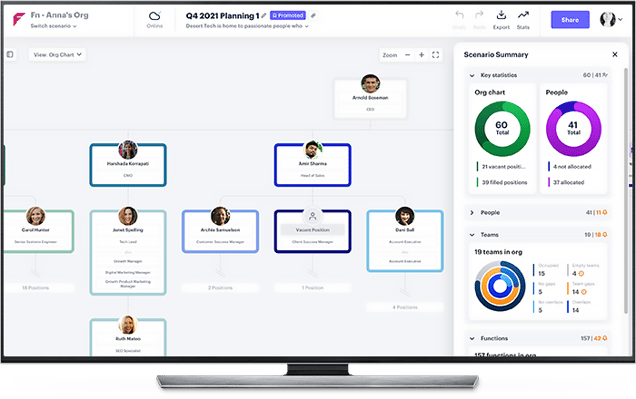As your business grows and evolves, you will find yourself involved in conversations about your future workforce needs. Eventually, the topic of headcount planning is going to come up.
Headcount planning isn’t just a trendy piece of organizational design terminology; it can help ensure you are able to achieve your business goals.
What is Headcount Planning?
Headcount planning is a type of workforce planning. It’s the process of planning to hire sufficient people based on your business needs. Those needs are defined by your organizational goals.
During the headcount planning process, you might establish concrete targets. For example, If you have very clear goals and a plan to pursue them, your headcount planning will be based on solid metrics. In other cases, headcount planning can be speculative.
Your team may create org charts based on many different scenarios. Considering these scenarios can help you determine which future goals are most realistic to pursue.
Why is Headcount Planning Important?
When done correctly, headcount planning helps you predict the roles you will need to add, reduce, or expand, leading to an optimized recruiting strategy. Additionally, a successful headcount planning initiative can fix staffing issues and ensure that everybody on your team can work productively.
Without good headcount planning, organizations often struggle with staffing issues. For leaders, staffing issues make it difficult to work toward company goals. For staff, these issues mean struggling to take on additional duties and dealing with the stress of inadequate support.
Who is Responsible for Headcount Planning?
Responsibility for headcount planning depends on the organization. In some companies, a dedicated HR team handles it in-house or works with a professional recruiter to understand future needs. Company executives often take part in this process.
It’s important to consider which business areas will be impacted by any forecasted changes. Department heads and managers often have valuable insights into how evolving business goals will affect their workforce needs.
Headcount Planning Concerns
It’s important that headcount planning is done correctly with all of the information made available. Otherwise, this could lead to problems like the following:
- Lack of agility in the face of unexpected events
- Increased staff turnover
- Under- or overestimating the amount of hiring that needs to be done
- Failed recruiting efforts
- Planning that is misaligned with business goals
Be aware of these potential issues as you create your own headcount planning methodology.

6 Steps to Successful Headcount Planning
The precise steps for headcount planning will vary from one organization to the next. However, you can guarantee your success if you use these steps as a guide.
1. Get Insights from All of Your Employees
Don’t make the mistake of relying solely on the insights of managers and department heads when you assess your hiring needs. While supervisors can offer valuable input, they may not have a complete view. It’s important to communicate with workers at every level — but that can be difficult if you have hundreds or thousands of employees.
Fortunately, you can use surveys, polls, focus groups, and other tools to gather information. Be aware that workers may be more willing to share if they can answer questions anonymously.
Because you are focused on workforce planning, you want to ask questions that will give you insights into morale, culture, alignment with company vision, and professional development. If the information you gather indicates high levels of frustration or overwork, keep these concerns in mind during headcount planning.
Good managers will also have excellent insights. They engage one-on-one with their team members and witness the most common sources of frustration. Managers should also tell you directly when they don’t have enough employees to operate their teams effectively, let alone reach for goals.
2. Conduct a Current State Analysis
Your headcount planning should be based on a solid analysis of your organization’s current state. You need to know what your workforce looks like right now — and where any skills gaps exist.
During this step, organizational chart software can be exceptionally helpful. It will help you visualize your staff, teams, and reporting structures. With the right integrations, you’ll be able to clearly define the skills and responsibilities for each role and determine whether the role is being filled.
Once you have this baseline understanding, you can take a closer look at your current human resources. How do employees’ experience, skills, and competencies measure up? Are there hiring gaps now? Will there be hiring gaps in the future based on new goals you intend to pursue or changes you believe will impact your business?
For example, your manufacturing team may be able to handle the current workload very well. But what happens if you decide to increase production by 25% or introduce a new product line that requires additional skills? Your future headcount plans will need to reflect this.
As you document the current state of your workforce, look beyond hard and soft skills. Diversity is also important. Employees from diverse backgrounds bring a variety of experiences and views to the table, and a diverse workforce is naturally more creative and adaptable. In fact, according to a Boston Consulting Group study, companies with more diverse management teams have 19% higher revenues.
Diversity is also a powerful recruiting tool. Diverse workplaces tend to attract the most skilled candidates. Include inherent and acquired diversity traits in your charts.
3. Gather and Organize Data
After your analysis, you will have a significant amount of data, including the number of employees, their skills, current salaries, unfilled positions, and so on. Gather additional information about your current hiring and recruiting budgets, funds available for new hire compensation, projected revenue, and other considerations.

4. Look Forward
Once you have identified staffing gaps and know where you stand, it’s time to look forward. Think of goals and upcoming events as landmarks on your company’s road map.
Determine whether you have the human resources to ensure your business thrives through any changes or the pursuit of new goals. Ask yourself if you have the right headcount in terms of numbers and competencies to meet future challenges.
What if your company doesn’t have any major changes or initiatives planned? Headcount planning is still important. For example, you always need to account for attrition and turnover.
Separation rates have been higher than usual for the past couple of years, but they seem to be slowly trending downward. For attrition rates, it may help to factor in 10% for planning purposes.
5. Get Stakeholders to Communicate
Stakeholders must do more than just take part in this planning; they must also communicate and collaborate with one another.
Business areas must work with HR to identify recruiting needs for the future and build strategies around those. Department heads can work together to identify duplicated efforts or discover chances to combine teams or move responsibilities around.
Information about headcount planning should never be siloed. Stakeholders should be encouraged to view any documents or charts created during workforce planning efforts as collaborative documents. Good communication ensures that everyone understands the relationships between teams and the flow of responsibility.
6. Make the Decisions
Now, you can use your data to create and finalize a plan for your future headcount. In this step, decide which new positions will be added, which duties and responsibilities will be given or taken away from certain roles, what kind of training you will offer to increase competencies, and how to budget for all of these things.
Headcount Planning for a More Successful Future
Companies that engage in successful headcount planning are better prepared for the future. They have the agility to deal with changes in the market and industry. Additionally, they can tackle new business goals and objectives because they are better prepared with the right human resources.
Software from Functionly is a valuable tool in headcount planning; it allows information to be organized, shared, and used collaboratively. It also gives planners the opportunity to plan out future scenarios.





